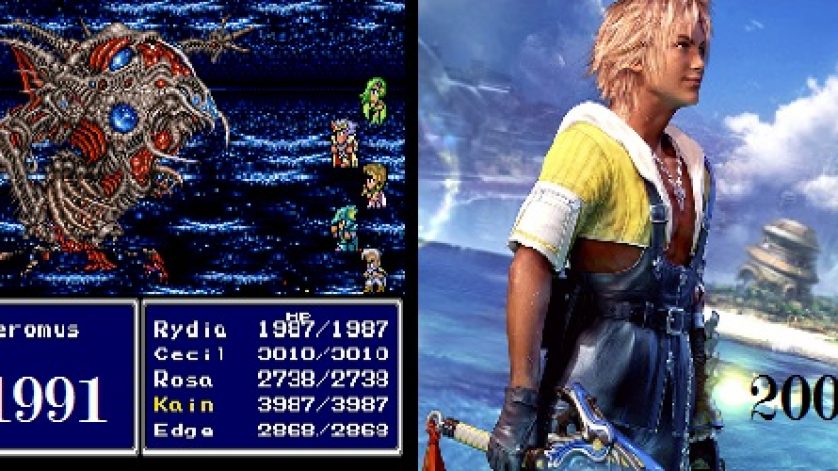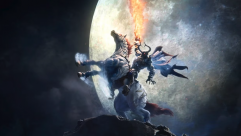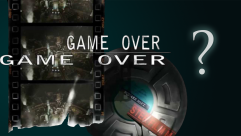
July 19, 2016 marks a very special day in Final Fantasy History. Two of the greatest Final Fantasy games ever were released on this day in history: Final Fantasy IV which celebrates 25 years since its launch in 1991 and Final Fantasy X which in turn celebrates 15 years since its launch in 2001. I have previously gone on record of calling Final Fantasy IV through Final Fantasy X the “Final Fantasy Golden Era” (with apologies to fans of the more recent entries). Given that this marks a mathematically appealing anniversary for two behemoths of the franchise, it seems prudent to take an in depth look at these two games, and how much the series managed to change in ten short years.
Be warned: There are massive spoilers for both games ahead!

Similarities
First off, we should start with some of the obvious similarities between these games. Like our beloved Final Fantasy VII, these two games were the first games of their console generation. Final Fantasy IV launched to mass popularity on the Super Famicom, eventually being ported to the USA on the SNES as Final Fantasy II (the proper FF2 and FF3 not having been released in the States). Final Fantasy X was the first Final Fantasy title on the Playstation 2.
Both of these games pioneered new battle systems, albeit with different overarching impact. Final Fantasy IV was the introduction of the Active Time Battle (ATB) system which became the mainstay of the series. Final Fantasy X temporarily shifted to the Conditional Turn-Based Battle (CTB) system and while it had its benefits (generally being a bit more accessible to newbies to the series) the ATB returned for X-2 and all subsequent non-MMO games up to the upcoming Final Fantasy XV.

The stories between these two games also have some thematic similarities. Both games feature a love-story, albeit pretty much every Final Fantasy game since IV has featured at least one romantic pairing. Both stories also touch on the idea of redemption, but again this is as much a similarity as it is a difference. Final Fantasy IV follows a literal redemption of the main hero Cecil – who turns his back on the life of a Dark Knight and the service to his lord in order to find solace. By comparison, Final Fantasy X treats the idea of redemption as a manacle, keeping people bound in despair while trying to chase a desperate, and impossible, hope. However there are cases of true redemption in X, such as Wakka overcoming his racist upbringing, Lulu making amends to her former summoner, Auron fulfilling his final duty to protect Tidus and the reconciliation on both fronts between Tidus and Jecht.
Then we have to address the fact that the main protagonist and the secondary villain have a filial bond. While this idea was started in Final Fantasy II (with the Dark Knight Leon being Maria’s brother), Final Fantasy IV and Final Fantasy X do have some of the better examples of this trope. Final Fantasy IV features a grand reveal near the end of the game that the villainous Golbez was in fact the mind-controlled brother of Cecil. This was pretty good for the shock value, though X’s execution was far better. Tidus learns early on that Sin is, in fact, Jecht – his estranged father. He then has the entire length of the game to figure out what that means, and to come to terms with the fact that he will have to kill what remains of his father. This dangling carrot of a plot point is handled, and resolved, beautifully. As a final note, it is interesting that the ultimate airship in Final Fantasy IV is the Lunar Whale and the primary villain in X is Sin which basically looks like a giant whale.

Differences
But enough about how they are similar, you want to know how they are different and how far the series has evolved. Well to start on my favorite turf – music – it is worth pointing out that Final Fantasy IV featured, naturally the work of Nobuo Uematsu. Final Fantasy X still had Uematsu as the primary composer, but for the first time in the series he was aided by two others – Junya Nakano and Masashi Hamauzu. Hamauzu would later go on to compose the majority of the tracks in the Final Fantasy XIII trilogy.
Final Fantasy IV broke new ground with the ATB system, but it was fairly conventional gameplay wise – a traversable world map (three, in fact) full of towns and dungeons to explore. Final Fantasy X, as we all know, was the first game to step away from the traditional overworld design, instead preferring a more “pretty line” world. To combat the lack of an overworld for tenting and saving, Save Spheres were scattered liberally throughout the world and automagically healed your party completely.

There are some near-misses in terms of story. While Cecil has it revealed that he is half-Lunarian and in a way, not like the others of his world, Tidus is a complete fish out of water, both from the fact that he is transported from the Zanarkand of the past to Spira and the later reveal that he is nothing more than a dream of the faith. On that same note both touch on the idea of a primarily medieval world (European medieval for Final Fantasy IV and Japanese medieval for Final Fantasy X) with an overarching technological super-power (The Lunarians and to an extent the Dwarves of Final Fantasy IV and Zanarkand of Final Fantasy X).
And I cannot talk about the differences in these two stories without bringing up their respective endings. The ending of Final Fantasy IV is a serene moment of repose followed by a triumphant curtain call. The only potentially sad moment is Golbez and the Lunarians decision to leave, but overall the ending is overwhelmingly happy. Final Fantasy X’s ending… is not. There is a bit of hope for the future of Spira, but the end is a dramatic tear-jerker as Tidus and Yuna say goodbye – a moment so powerful a Japanese commercial recreated this moment in a variety of ways (complete with a number of people breaking out into piteous sobs) to sell the X / X-2 remaster. Heart-wrenching? Absolutely, but many consider this one of the finest (if not the finest) endings in the franchise’s history. Yours truly is no exception and, upon reflection, I consider this ending to be only second to Final Fantasy 6.

Conclusion
There are many many more avenues to discuss. Final Fantasy’s introduction of voice acting, Final Fantasy IV’s large and ever-changing cast. The distinctly different leveling systems (though every level system has been unique in its own way). But for every minor point we bring up about the ways in which they share similarities of have noted differences, we can’t quantify something that ultimately, matters more than anything else. How the game feels to us, the players. What makes these games among the greatest in the franchise? Well your answer could be very different from mine or nearly identical. We can see the series evolve clearly just by looking at these two games divided by a decade. Some of us have adapted to the change. Some of us prefer the good old days. Some of us weren’t even around when these games launched. But they have stood the test of time and, for whatever the reason you choose, they remain classics to this day.






No comments yet
Log in or Register
No comments yet
Be the one to start the conversation!